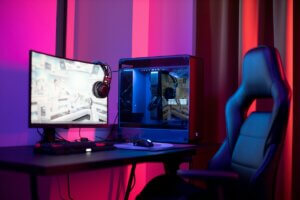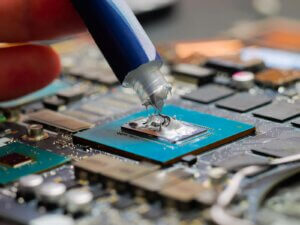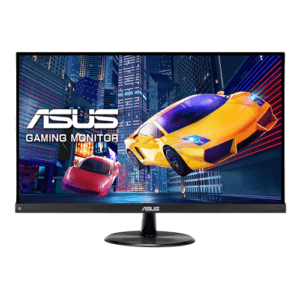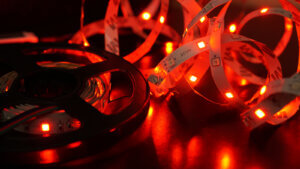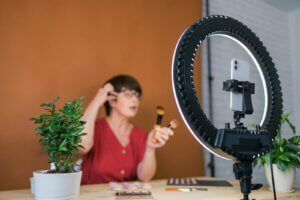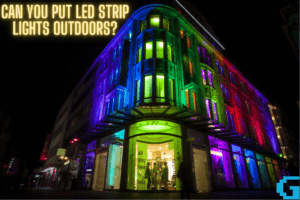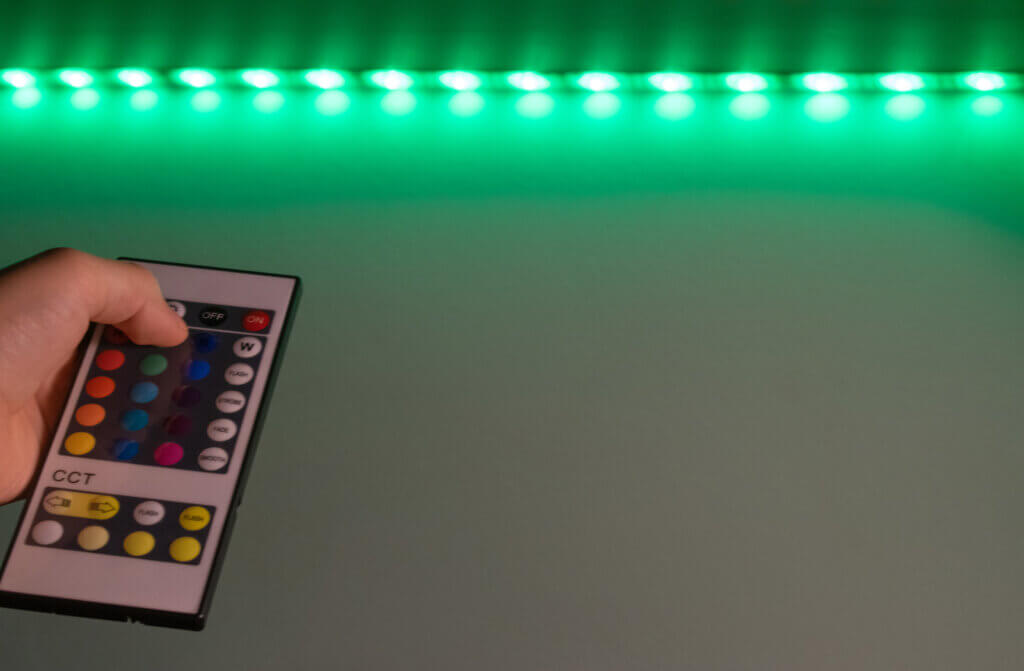LED strip lights are one of the most popular LED products. Because of their sticky backs, you can connect them almost anywhere as long as they are close to a power outlet. Keep reading if you want to know how to hang LED strip lights on walls without adhesive.
What are LED strip lights?
LED strip lights are a type of decorative lamp. People often use them in home design because they are easy to set up and change.
You can change them to create the kind of atmosphere you want. They can increase the light in a room and add different light colors.
For example, putting an LED strip up in the living room can make it feel cozier for the whole family. They can also make parties and events like weddings feel happier.
Can you stick LED strip lights on walls?
Walls that have LED strips look great. LED light strips are often put on walls, one of their most ordinary places.
There are many ways to light up walls with LED light strips. But each of these methods falls into one of three groups:
Lights in the ceiling
In recessed lighting, LED strips stick out of a hollow part of the wall. This is great for making your house a nice place to live in.
This wall lighting can be used in homes, businesses, and public places to make the area look even more elegant.
Lights that look good on the walls.
You can also make LED light strips that look great on the wall. You could use RGB or RGBW LED strips to make art on your empty walls and let your creative mind run wild.
Because they are easy to put up and take down, these strips are great for decorative lighting. You can also keep using them repeatedly.
Lights that are fixed to a surface
Surface-mounted lighting uses LED strips that are put on the surface of the wall. People often choose this type of lighting when they need bright, unfiltered light.
Do LED strip lights damage paint?
Depending on the circumstances, LED strip lights are not likely to cause wall damage. How well they stay in place depends on the weather, how wet their glue is, how long the paint lasts, and how long they have been in place.
There are many different sizes and colors of LED strips, but they all have 3M adhesive on the back. This glue is made of a polymer that works very well. So, it is called the strongest tape on the market.
This amazing tape can be used as a solid or a thick liquid. This feature keeps the strip from moving around on uneven surfaces and makes it possible to make a solid accessory.
How to Hang LED Strip Lights on Walls Without Damaging Paint
Whether you want to turn your home into a happy vacation paradise or make a few minor changes, lights can take your space to the next level. You might already imagine what the finished project will look like: beautiful, peaceful, engaging, and inspiring. You can’t do it because you’d have to use heavy tools and make holes in the walls. You’ve come to the right place if you want to know how to hang lights without nails or without damaging your walls and their paint.
How to Hang LEDs without Adhesive
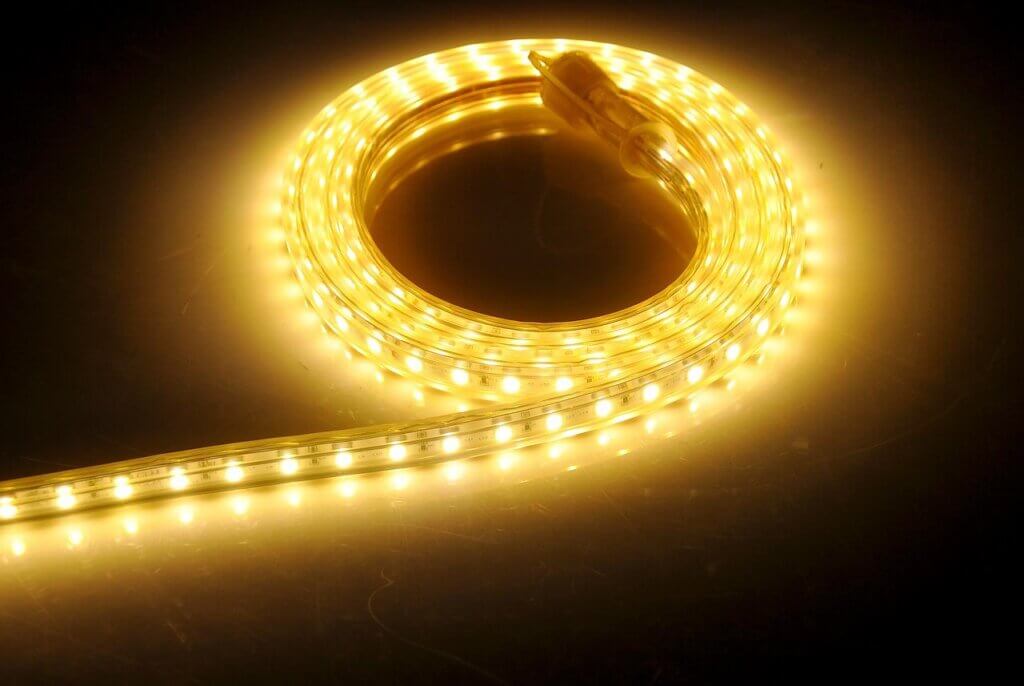
Try something else if you’re worried about the tape ruining the paint on your walls.
Putting putty down is another option. This is a suitable, portable replacement for glue, nails, and staples. Use your hands to shape a piece of clay into your desired shape.
Press the putty right into the back of your light strips. After that, you can put the LED strip where you want it.
Using installation clips is another way to mount LED strips. This method is easy and cheap to approach LED strip lights without double-sided tape.
You must screw the mounting clip along the length of the strip. A lot of placing clips have a place where the strip can go.
Use several clips per foot to hold your LED strip in place. These clips are great if you want to point your LED lights down.
Using a lightweight aluminum placement channel is another inexpensive way to mount LED strips in a way that looks professional. In this method, the strips stick to the light aluminum channel, so an adhesive layer is needed.
The tape and aluminum go well together and make a strong bond. Clips that stick to the surface are then used to keep the network in place.
The channel and UV-protected cover make your lights look like a pro-made them. No one would think they were strip lights for sure.
How to hang lights in a room without Nails
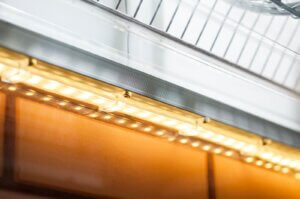
You can hang lights and decorations without picking up a hammer if you are creative and have the right tools. Check out these easy ways to hang lights without nails for the easiest way to hang things.
Lights and decorations may be hung without using a hammer with just a little ingenuity and the correct tools. If you’re looking for the least stressful method to install lights, try one of these nail-free options.
Sticky Clips
Firstly, use the sticky clips.
You may decorate the house without the hassle of nails by using adhesive hooks or clips. Depending on your situation, you may choose from a wide variety of sticky hooks and clips. Some are stronger, which is helpful for heavier wreaths or longer strings of lights in unusual forms like candy canes or snowflakes. Tiny hooks are ideal for stringing up fairy lights and hanging banners and garlands. It’s as simple as peeling, sticking, and applying for an instant transformation.
Encircle commonplace items.
When it comes to finding a way to install lights without using nails, just about anything in the home may be put to use. Ordinary home items like slats, curtain poles, and furniture may all benefit from having lights wrapped around them. Another exception to the rule that lights must be hung on walls is the ceiling. Go crazy with your thoughts.
Galaxy projectors
You don’t need to limit yourself to string or fairy lights if you want to illuminate a space without using any nails. Galaxy projectors can cover a wall or ceiling up to 900 square feet from as little as 10 feet away. This illumination level is more than simply functional; it’s also a way to fill your space with unrivaled visuals.
Consider the Sky Lite 2.0 as an example. It can turn any special occasion or quiet evening into an out-of-this-world experience by projecting a dazzling sky full of stars and multicolored nebula clouds onto the ceiling. You can adjust the hues, patterns, and effects with the touch of a finger on your smartphone screen. Then, without using tools other than your eyes, sit back and allow your lights to transport you far away.
Drape over the couch.
Lighting fixtures should not be limited to either the walls or the ceiling. In the absence of other lighting sources, hanging lights over pieces of furniture may serve as a suitable substitute. Locate a solid piece of furniture next to a power outlet, plug in your lights, and you’re set to go. Light up the room by draping lights over various surfaces, such as bookcases, coffee tables, headboards, TV racks, and even the dresser. Because of how simple it is, you may never want to use nails again.
Sucking wires
It’s best to avoid having lengthy strings of lights impeded by windows. Hanging holiday or party lights from windows is as easy as pressing hooked wire suckers, which are essentially suction cups, into the glass. Welcome Rudolph and his pals with red and green LEDs, and then switch them out for sweet lights in time for Valentine’s Day.
Wrapped Balustrades
Put up some string lights to decorate the hallway leading to the kids’ bedroom for the holidays. Install them along the railings of your stairs to give your children a magical sight as they go upstairs to bed. The banister may be lit up in a jiffy if an accessible outlet or extension cable is nearby. Simply arrange your wires so people won’t trip over them, and you can easily convert your area for the holidays or any other event.
Putty that sticks
Adhesives like Blu Tack are recyclable solutions that can hold tiny things without damaging the wall. It shines brightest when used with fairy lights or other similar light objects. Simply push the wire or LED bulbs into the putty at regular intervals to secure them. Do so when you’re ready to switch on the lights after pushing the putty onto the wall. With these tips, you can make your home feel more welcoming and calm your mind right away.
Make use of stone and mortar clips.
One’s fireplace mantle may hold more than just stockings. Masonry clips allow you to hang rope lights directly from the brick of your fireplace, giving your living area a dramatic new look. These clips have a special shape that allows them to grip bricks (a common problem with regular clips) without damaging the bricks or leaving any sticky residue behind. Each clip has a single or double hook to let you decorate your house with bright lights.
The HolidayPort USB Christmas Light is a perfect addition to your mantel string lights. When you turn on this light, Santa and the Snowman will be dancing in a joyous celebration above your fireplace when you turn it on. Relax with some hot chocolate while listening to seasonal tunes and reading a good book with the accompanying light, which can be plugged into any USB port. Having Santa and the snowman around can make your home seem cozier and more festive.
Pushpins
You know how you have a bunch of pushpins that you have collected over the years but never seem to use? Then put them to good use in a nail-free light fixture. Pushpins may be little, but they pack a powerful punch. Fairy and string lights don’t weigh enough to tug on a pushpin, so they fit perfectly in the tight spaces between the tangled wires.
There are a wide variety of pushpin designs available. They do make holes in the wall, but they are far smaller and simpler to repair than those made by nails. You may keep your lights up year-round or switch them out for different occasions.
Curtain rod
Use objects around the home for more than one use to maximize their value. Although you may only be familiar with using curtain rods to hang curtains, you can also use them to hang string lights. The light may be fastened to the rod by wrapping it in electrical tape or zip ties. You can turn your window seat into a fantastical wonderland with one quick move.
Staples
Let’s assume you don’t want to damage your walls by hammering nails into them, so you’re thinking about how to hang lights in your room. Small holes, approximately the size of a nail, don’t bother you since they could be less obvious than larger ones and might be patched more easily. Your best bet would be to use staples to attach the lights to the wall. This procedure takes very little time and causes little disruption to your walls. And most staples won’t be too noticeable next to your wiring or in the way of your ethereal illumination.
See-through tape
At this very moment, you do not recognize it; later, you will. String lights may give the appearance that they are floating in midair, thanks to transparent tape. If you want your lights to last as long as possible, you should use the thickest standard or double-sided clear adhesive tape you can find. The maximum weight certain tapes can support is 15 pounds, and they are weatherproof and durable. With this tape, you can easily hang lights from your balcony ceiling.
Tape should be used only on the cables connecting your light bulbs, never on the bulbs themselves. Lights can dramatically change the mood, and this method keeps them from getting lost.
Magnets
As noticed from an answer on Quora, most houses have metal screws hidden inside the wall. This means you can buy small but strong, screw-sized magnets which you can sit on top of the hidden screws in your wall. Then go ahead and glue your LED lights to the magnets!
Clear Cable Ties
Cable ties are a great option if you have something to connect your LED lights to. Using cable ties means that if you want to remove the LED strip in the future, you can simply cut the ties and take down the LED strip.
Using Adhesives: Without Damaging Wall Paint
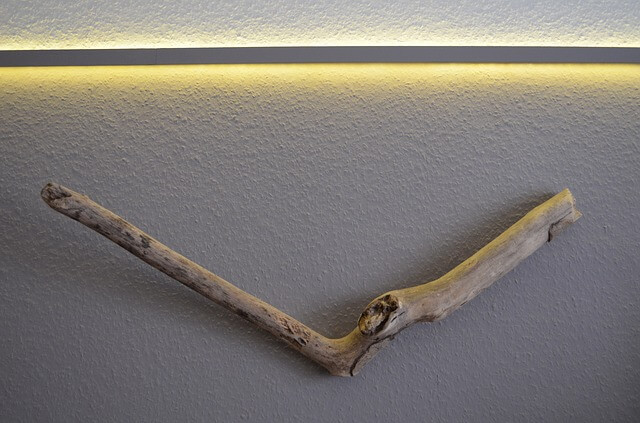
On smooth surfaces, adhesives are an ideal alternative to avoid damaging your walls or the paint on these walls.
Follow the steps below to tape your LED strips to the wall without ripping off the paint. Here’s how it works:
Plan
Start by figuring out how big the area is where you will put the lights. To do this, use a measuring tape or a ruler. Do not speculate.
Make sure your LED strip is the correct length.
Use scissors or a sharp blade to cut your LED lights to the correct length. Just cut along the lines that say “reduce” on the paper.
If you cut your strip at the wrong point, you will damage the wiring and make some LEDs useless. If you did that, you need to add another link.
Get the area ready.
The glue on the back of LED light strips works best on smooth, clean walls. If there is dust or grease on the surface, the adhesive will also not stick. A limited bond would undoubtedly be impossible to make.
Wet a clean dustcloth with rubbing alcohol or warm water to stop this from happening. Clean the area with force and care. When you’re done, use a paper towel or something else without lint to dry the surface.
Your LED strips will stay together longer if they are on a clean surface.
It works great for putting strip lights on flat, smooth surfaces. It would work better if you didn’t use it on rough or textured surfaces or on ones that bend or move.
For a strong bond, the adhesive support needs a flat surface. The LED strip doesn’t stick well to rough or oily surfaces. Most likely, it will just move around and not stick at all.
Take off the piece of plastic on the back of the LED light strip.
The LED strips are wound around a spindle and are ready to use. Spread out the length of light you’re going to use for your project.
To find the support for the sticky layer, gently pull the plastic sheet from either end of the LED strip. Remove the tape slowly so that oil or dirt doesn’t get stuck to it.
Put the LED strip in place and stick it down.
Place the LED light strip where you want to put it, and then gently push it in place with your hand. Use only a light touch.
Keep pulling and pushing until it sticks completely. Do not rush. Take your time to make sure you do a good job.
Switch on the lights.
Connect your LED strip lights to the power source. Start being amazed by how your LED strip lights change things.
First, use the push button to separate the insulation sheet. The next step is to choose the color you want.
How To Remove LED Lights from any Surface
Ensure the LED light strip is unplugged before heating the adhesive back with a hairdryer. Carefully removing it from the wall will prevent any damage to the paint. The light strip may then be relocated using a low-cost double-sided adhesive backing.
If you wanted to remove LED light strips with less risk and harm, you should have done the following:
- First, make sure the lights are off before doing any repairs.
- The second step is to heat the adhesive using a hairdryer. The tape will soften from the heat, making removing it easier without leaving many marks on the skin. But don’t waste too much time puffing air. You have two minutes to do this.
- Use anything thin and blunt, like a butter knife, to push it under the strip.
- Give it a little wiggle to loosen the adhesive, then peel it off carefully. Try to take things easy and slowly.
- Do that with one hand; with the other, gently pull the LED strip or have a buddy help you.
- With some work, you should be able to remove the adhesive completely. Any smudges left on the wall must be removed. Quickly wipe it away with an orange-or lemon-based cleaner.
For more information, we have a full article on removing LED lights.
FAQs
Can LED strip lights cause damage to wall paint?
Depending on the wall, LED strip lights may or may not be safe for your walls. How well LED strips stick to a surface depends on many things, such as the strength of the adhesive, the durability of the paint or wallpaper, how long it’s been since they were put on, and the weather.
Are LED strip lights bad for wooden floors?
Most modern LED lights do not generate enough warmth to spark or damage the wood. If you want to be certain, you should switch on the lights and keep them on for at least an hour under conditions that mimic those in which they’d be in contact with wood.
How can LED strips be hung without causing damage to the wall?
An electrical extension cable or power strip might facilitate your work. Suppose you switch on your LED lights and see that they aren’t completely straight. In that case, you may fix this by gently removing the lights from the wall and rotating each strip of lights until they are straight (use a level if possible).
How can I secure LED lights to a wall?
3M makes the adhesive backing of most LED strips. The strips’ adhesive backing may be peeled off when the surface is ready and after they have been trimmed to size. Apply light pressure as you push the strip onto the appropriate surface.
Can the paint be removed by using LED light strips?
Walls that are dusty, rusted, unprimed, or filthy will not accept paint well. LED strip lights will significantly reduce the strength of your paintwork and make it more vulnerable to damage. The wall itself won’t be damaged in any way, but there will be a noticeable patch where paint has been scraped away.
Do LEDs attract bugs?
Bugs are less likely to be attracted to LED lights than traditional incandescent lights. And yet, they do improve the efficacy of insect lights. When compared to standard insect zappers, the LED alternatives are far less noisy.
Related Content:
How to hang LED strips without damaging the wall
How much electricity do LED strips use?
Can you put tacks in LED strips?
Author
-
Gaming For PC (or GFPC for short) is made up of a small team of gamers, content creators, editors, and web design experts.
View all posts
